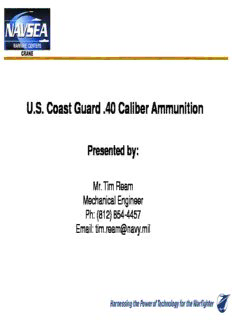
US Coast Guard .40 Caliber Ammunition PDF
Preview US Coast Guard .40 Caliber Ammunition
U.S. Coast Guard .40 Caliber Ammunition Presented by: Mr. Tim Ream Mechanical Engineer Ph: (812) 854-4457 Email: [email protected] .40 Caliber Ammunition History .40 S&W was introduced in the late 1980’s as a law enforcement cartridge Developed jointly by Winchester and Smith & Wesson Testing revealed that a reduced velocity 10mm cartridge achieved 10mm .40 S&W desired terminal performance Less powder .40 Caliber Ammunition Transformation Less recoil than conventional 10mm ammunition More airspace in the cartridge case 10mm case could be shortened enough to fit within the medium-frame handguns Small pistol primer replaced the large pistol primer used in the 10mm cartridge 10mm .40 S&W New cartridge developed – 40 S&W .40 Caliber Ammunition Requirement Department of Homeland P229 Security chose .40 caliber as the common carry pistol Sig Sauer P229 & P239 were chosen as the P239 replacement service pistols of the USCG .40 Caliber Ammunition Requirement (continued) USCG initially procured commercial ammunition to support new service pistol USCG directed NSWC Crane to obtain full type qualification for 3 cartridge types 155 grain ball 155 grain jacketed hollow point 155 grain frangible .40 Caliber Ammunition Performance Requirements Performance requirements developed around the performance of commercial rounds procured by USCG SAAMI dimensional requirements Standard small pistol primer (Ball & JHP) Non-toxic primer (Frangible) Pressure & velocity - SAAMI Accuracy – 1.5” average mean radius @ 25 yards, Ten 5-shot groups, ransom rest Waterproof (Ball & JHP) – bubble test .40 Caliber Ammunition Performance Requirements (continued) Function – P229 & P239 Penetration – JHP Bare gelatin @ 10’ & 25 yards Gelatin with 4 layers of clothing @ 10’ Autoglass @ 10’, gelatin with 2 layers of clothing placed 18” behind glass Top edge of the glass will be tilted back 45 from vertical and angled 15 from the pistol’s line-of-sight Simulated car door @ 10’, gelatin with 2 layers of clothing placed 18” behind door .40 Caliber Ammunition Performance Requirements (continued) Penetration – Frangible 3/8” AR500 steel plate @ 5’, 50 shots into ½” diameter impact area shall not penetrate and no fragments shall return to the shooters position Type II Body Armor @ 15’, 3 shots shall not penetrate, greater than 2” from previous shot, greater than 3” from edge Ballistic match (Frangible) – center of impact less than 2-1/2” from center of impact of standard ball ammunition (MK 309 MOD 0) .40 Caliber Ammunition Solicitation for Contract Full and open competition All 3 cartridge types $15M 5 year IDIQ contract awarded to Federal Cartridge Company for Ball & JHP cartridges .40 Caliber Ammunition Solicitation for Contract .40 Caliber 155 Grain Projectiles (continued) No contract award for 155 grain frangible cartridge No samples met specification requirements Frangible projectiles are larger than ball projectiles of the same weight due to varying material densities Ball JHP Frangible Unable to meet the required velocity and ballistic match with 155 grain frangible projectile
Description: